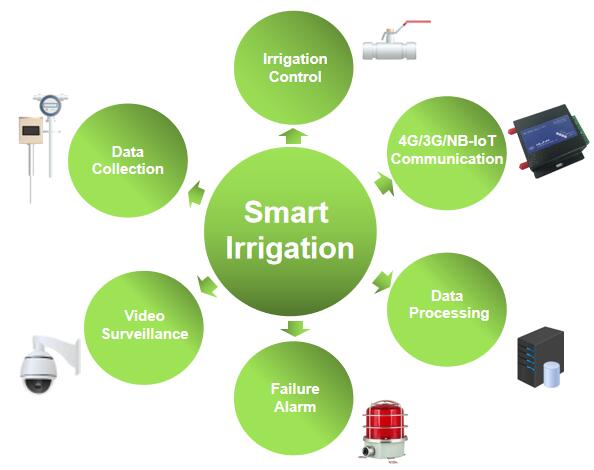
HOME > Case > Energy > Smart Irrigation
Background
The smart agricultural irrigation system leverages 4G/3G/NB-IoT connectivity combined with automated control technology to deliver precision irrigation. By monitoring real-time data on crop water requirements, weather conditions, and soil moisture levels, the system accurately determines when and how long to irrigate. This approach not only enhances water resource utilization and addresses water scarcity challenges but also increases crop yield and reduces overall production costs.
Wlink Solution
WLINK’s solution integrates a 4G/3G/NB-IoT modem and RTU to wirelessly transmit farm meteorological and soil moisture data to a centralized data center. The data center processes this information and compares it with predefined irrigation thresholds. When the data indicates that irrigation is needed, a command is sent to the WLINK Cellular Modem/RTU to activate the solenoid valves and start the pump according to preset irrigation schedules.

Features

The smart irrigation system includes several key components:
1. Data Acquisition
Sensor Integration:
Automatic weather stations and soil moisture sensors continuously gather essential environmental data.
2. Irrigation Control
Automated Operations:
By controlling solenoid valves, the system manages pump operation to support various irrigation modes, including automatic, scheduled, periodic, and manual.
3. Cellular Data Communication
Robust Connectivity:
The WLINK 4G/3G/NB-IoT modem/RTU transmits sensor data to the data center and provides a secure channel for remote control of irrigation equipment.
4. Data Processing
System Configuration:
Operators can set data acquisition intervals, system execution parameters, and other operational conditions.Real-Time Display:
Collected data is presented in real time via charts and reports, allowing for immediate analysis.Remote Command Execution:
Control commands are relayed to the irrigation system via the cellular module, managing the on/off status of the solenoid valves.Automated Irrigation:
Irrigation is triggered automatically when sensor readings meet or exceed the preset thresholds.
Benefits
Customizable Irrigation Modes:
Multiple irrigation strategies can be tailored to suit specific field conditions, maximizing water efficiency.Remote Monitoring and Control:
Cellular connectivity enables remote management, reducing manual labor and streamlining operations.Data-Driven Management:
Advanced data processing provides quantitative insights into water demand for different crops at various growth stages.Water Conservation:
Precision control ensures that only the necessary amount of water is used, significantly reducing waste.
Related Products
WL-D80 serial port to IP 4G/3G/NB-IoT modem
WL-RT600 4G/3G RTU
Industrial robust, heavy-duty metal enclosure for extreme environments
4G/3G/NB-IoT network optional
Strong electromagnetic interference Resistance
Built-in watch dog, Multi-link detection
Multiple operation modes
Rich Serial and I/O interfaces
Programmable for user-defined I/O and Modbus
Flexible and practical data communications
Built-in RTU Clock
Data storage optional
Friendly configuration tool
WLINK RTU Management Platform











